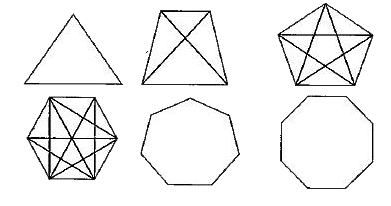
For a polygon, d and n are related as d=An2+Bn, the values of A and B are
A=12,B=32
A=12,B=−32
A=12,B=32
A=−12,B=−32
Step by step video & image solution for For a polygon, d and n are related as d=An^(2)+Bn, the values of A and B are by Maths experts to help you in doubts & scoring excellent marks in Class 10 exams.
Updated on:21/07/2023Topper's Solved these Questions
- SAMPLE PAPER 13BOOK - EDUCART PUBLICATIONCHAPTER - SAMPLE PAPER 13EXERCISE - PART B (SECTION-III)
8 Videos
- SAMPLE PAPER 13BOOK - EDUCART PUBLICATIONCHAPTER - SAMPLE PAPER 13EXERCISE - PART B (SECTION-IV)
6 Videos
- SAMPLE PAPER 13BOOK - EDUCART PUBLICATIONCHAPTER - SAMPLE PAPER 13EXERCISE - PART - B (SECTION - V)
4 Videos
- SAMPLE PAPER 11 (SELF - ASSESSMENT)BOOK - EDUCART PUBLICATIONCHAPTER - SAMPLE PAPER 11 (SELF - ASSESSMENT)EXERCISE - SECTION -C
10 Videos
- SAMPLE PAPER 2 BOOK - EDUCART PUBLICATIONCHAPTER - SAMPLE PAPER 2 EXERCISE - SECTION - D
9 Videos
Similar Questions

For a polygon, d and n are related as d=An2+Bn. The relations for a triangle and a quadrilateral are
View SolutionA stop sign is an example of a Polygon, in the image, you can see examples of diagonals in geometry in the stop sign. Hence, there a various number of diagonals possible in a Polygon.

The number of diagonals (d) that can be drawn in polygons with a given number of sides (n) is being investigated.


On the basis of the above information, answer any four of the following questions:
For a polygon, d and n are related as d=An2 + Bn . The relations for a triangle and a quadrilateral are
View Solution
Knowledge Check
B.O.D is related to
AdetergentsBputrescibilityCinorganic pollutantsDorganic pollutants.If the sum of n terms of an A.P. is given by Sn=a+bn+cn2,wherea,b,c are independent of n,then a=0 common difference of A.P. must be 2b common difference of A.P. must be 2c first term of A.P. is b+c
Aa≠0Bd≠3bCd = 2cDfirst term of an AP is b-cHow is D related to A?
I. B is the brother of A.
II. B is D's son.Aif the data in statement I alone are sufficient to answer the question, while the data in statement II alone are not sufficient to answer the question,Bif the data in statement II alone are sufficient to answer the question, while the data in statement I alone are not sufficient to answer the question,Cif the data either in statement I alone or in statement II alone are sufficient to answer the question,Dif the data given in both statements I and II together are not sufficient to answer the question,
If the points A(3, 5)and B(1, 4) lie on the graph of the line ax+by=7, find the values of a and b
View Solution(a) In the formula tn=[a+(n−1)d], make 'n' as the subject.
(b) find the value of n when tn=92,a=1andd=13.
View SolutionIn Figure, BM and DN are both perpendiculars to the segments AC and BM=DN . Prove that AC bisects BD

View SolutionIf roots of an equation xn−1=0are1,a1,a2,.....an−1, then the value of (1−a1)(1−a2)(1−a3)(1−an−1) will be n b. n2 c. nn d. 0
View SolutionLet f, g and h be real-valued functions defined on the interval [0, 1] by f(x)=ex^2+e−x^2, g(x)=xex^2+e−x^2 and h(x)=x2ex^2+e−x^2 . If a,b, and c denote respectively, the absolute maximum of f, g and h on [0, 1], then a=b and c≠b (b) a=c and a≠b a≠b and c≠b (d) a=b=c
View Solution
